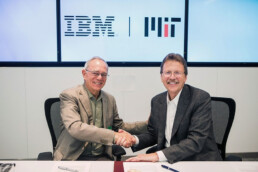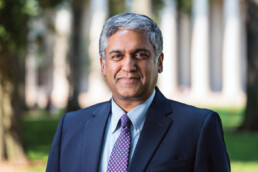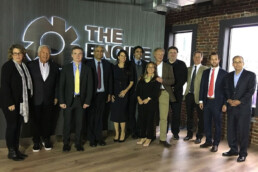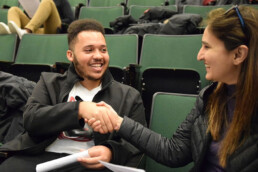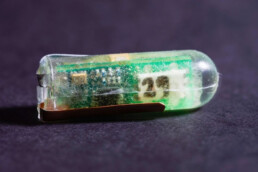IBM and MIT to pursue joint research in artificial intelligence, establish new MIT-IBM Watson AI Lab
IBM plans to make a 10-year, $240 million investment in new lab with MIT to advance AI hardware, software, and algorithms.
IBM and MIT today announced that IBM plans to make a 10-year, $240 million investment to create the MIT–IBM Watson AI Lab in partnership with MIT. The lab will carry out fundamental artificial intelligence (AI) research and seek to propel scientific breakthroughs that unlock the potential of AI. The collaboration aims to advance AI hardware, software, and algorithms related to deep learning and other areas; increase AI’s impact on industries, such as health care and cybersecurity; and explore the economic and ethical implications of AI on society. IBM’s $240 million investment in the lab will support research by IBM and MIT scientists.
The new lab will be one of the largest long-term university-industry AI collaborations to date, mobilizing the talent of more than 100 AI scientists, professors, and students to pursue joint research at IBM's Research Lab in Cambridge, Massachusetts — co-located with the IBM Watson Health and IBM Security headquarters in Kendall Square — and on the neighboring MIT campus.
3Q: Anantha Chandrakasan on new MIT–IBM Watson AI Lab
Lab seeks to expand the boundaries of research on artificial intelligence.
MIT and IBM jointly announced today a 10-year agreement to create the MIT–IBM Watson AI Lab, a new collaboration for research on the frontiers of artificial intelligence. Anantha Chandrakasan, the dean of MIT’s School of Engineering, who led MIT’s work in forging the agreement, sat down with MIT News to discuss the new lab.
Q: What does the new collaboration make possible?
A: AI is everywhere. It’s used in just about every domain you can think of and is central to diverse fields, from image and speech recognition, to machine learning for disease detection, to drug discovery, to financial modeling for global trade.
This new collaboration will bring together researchers working on the core algorithms and devices that make such applications possible, enabling the pursuit of jointly defined projects. We will focus on basic research and applications, but with new resources and colleagues and tremendous access to real-world data and computational power.
The project will support many different pursuits, from scholarship, to the licensing of technology, to the release of open-source material, to the creation of startups. We hope to use this new lab as a template for many other interactions with industry.
We’ll issue a call for proposals to all researchers at MIT soon; this new lab will hope to attract interest from all five schools. I’ll co-chair the lab alongside Dario Gil, IBM Research VP of AI and IBM Q, and Dario and I will name co-directors from MIT and IBM soon.
Anantha Chandrakasan named dean of School of Engineering
Head of Department of Electrical Engineering and Computer Science will succeed Ian Waitz.
Anantha P. Chandrakasan, the Vannevar Bush Professor and head of the Department of Electrical Engineering and Computer Science (EECS), has been named dean of MIT’s School of Engineering, effective July 1. He will succeed Ian A. Waitz, the Jerome C. Hunsaker Professor of Aeronautics and Astronautics, who will become MIT’s vice chancellor.
During his six-year tenure as head of MIT’s largest academic department, Chandrakasan spearheaded a number of initiatives that opened opportunities for students, postdocs, and faculty to conduct research, explore entrepreneurial projects, and engage with EECS.
Anantha Chandrakasan hosts Apple CEO Tim Cook at The Engine
MIT students present their work to Apple CEO Tim Cook
Two minutes. Maybe three. That’s all students had in which to deliver the juiciest highlights of their work to MIT commencement speaker and Apple CEO Tim Cook. But on the day before he would address 2017 graduates, Cook was whipping across campus to several meetings to soak in what makes MIT unique.
As the afternoon sun burnished Massachusetts Avenue, Cook walked into a conference room at MIT’s startup accelerator The Engine, where the students were waiting. Representing diverse programs across campus, the seven presenters somehow squeezed their accomplishments into the allotted time.
“So impressed by @MIT students & faculty who are finding new ways to tackle the world’s biggest challenges,” Cook said on Twitter. “Thanks for sharing your work!”
MIT pilots full-credit online residential course
Campus students report more flexibility, reduced stress in taking an online version of a popular MIT course.
Last fall, the Department of Electrical Engineering and Computer Science (EECS) and MIT Office of Digital Learning piloted a full-credit online course for a small cohort of residential students. The popular 6.002 (Circuits and Electronics) was offered as 6.S064, leveraging an existing massive open online course (MOOC) available via the edX platform and adding a private discussion forum for MIT students.
The Teaching and Learning Lab conducted an assessment of this pilot, which is now published as an internal working paper. This preliminary assessment suggests that there are benefits to an online-while-on-campus course format. Specifically, the students who completed 6.S064 reported more flexibility with scheduling and less overall stress relative to their traditional classes. While the findings are based upon a small sample, the pilot bodes well for the possibility of allowing more student choice in how and when they learn.
The Engine closes its first fund for over $150 million
MIT’s new accelerator will now focus on selecting startups.
Just months after its launch, MIT’s new startup accelerator The Engine yesterday closed its first investment fund for over $150 million, which will support startups developing breakthrough scientific and technological innovations with potential for societal impact.
With funding secured and leadership in place, The Engine is now focusing on selecting its first group of investments this year.
Announced at a launch event last October, The Engine combines an accelerator, an open network of technical facilities, and a fund, which together will provide stable financial support and access to costly resources for startups. Focus will be given to startups developing “tough” technologies — breakthrough ideas that require time to commercialize — in a range of sectors including robotics, manufacturing, health tech, biotechnology, and energy.
Researchers devise efficient power converter for internet of things
Design reduces converter’s resting power consumption by 50 percent.
The “internet of things” is the idea that vehicles, appliances, civil structures, manufacturing equipment, and even livestock will soon have sensors that report information directly to networked servers, aiding with maintenance and the coordination of tasks.
Those sensors will have to operate at very low powers, in order to extend battery life for months or make do with energy harvested from the environment. But that means that they’ll need to draw a wide range of electrical currents. A sensor might, for instance, wake up every so often, take a measurement, and perform a small calculation to see whether that measurement crosses some threshold. Those operations require relatively little current, but occasionally, the sensor might need to transmit an alert to a distant radio receiver. That requires much larger currents.
Voice control everywhere
Low-power special-purpose chip could make speech recognition ubiquitous in electronics.
The butt of jokes as little as 10 years ago, automatic speech recognition is now on the verge of becoming people’s chief means of interacting with their principal computing devices.
In anticipation of the age of voice-controlled electronics, MIT researchers have built a low-power chip specialized for automatic speech recognition. Whereas a cellphone running speech-recognition software might require about 1 watt of power, the new chip requires between 0.2 and 10 milliwatts, depending on the number of words it has to recognize.
Secure wireless chargers
New chip would thwart the counterfeiting that plagues the market for wired device chargers.
Counterfeit chargers for portable electronics are a major problem. At the end of 2016, Apple claimed that of 100 Apple-branded charging accessories it bought on Amazon, 90 were counterfeits. Around the same time, Britain’s Chartered Trading Standards Institute reported that of 400 counterfeit chargers it bought from a range of online retailers, 397 failed a basic safety test.
In the last few years, portable electronics that can be recharged wirelessly have started coming to market. In an effort to get ahead of the problem of counterfeit wireless chargers — which could cause power surges that fry a device’s circuitry — researchers from MIT’s Microsystems Technology Laboratories have built a chip that blocks attempts to wirelessly charge a device’s battery unless the charger first provides cryptographic authentication.
Make it your business
StartMIT, a boot camp on entrepreneurship, gives students an intimate look into what it takes to build a company.
If you daydream about founding a startup, know this: CEOs are made, not born. Theodora Koullias ’13 — founder of the tech-fashion company Jon Luu — explained on Jan. 17 to a group of students and postdocs what it’s really like. “You learn on the job all the time.”
Koullias candidly shared her experience as part of StartMIT, a course packed with practical instruction and mentorship, designed to give aspiring entrepreneurs a boost up the founder learning curve. Held Jan. 9-23 during MIT’s Independent Activities Period, StartMIT gave participants a chance to form teams and develop their ideas into venture capital-worthy pitches. Students learn about the smorgasbord of ingredients that go into making a startup: creating a value proposition, staking a claim to intellectual property, working with the press, networking, creating culture, and, of course, raising money.
Engineers harness stomach acid to power tiny sensors
Ingestible electronic devices could monitor physiological conditions or deliver drugs.
Researchers at MIT and Brigham and Women’s Hospital have designed and demonstrated a small voltaic cell that is sustained by the acidic fluids in the stomach. The system can generate enough power to run small sensors or drug delivery devices that can reside in the gastrointestinal tract for extended periods of time.
This type of power could offer a safer and lower-cost alternative to the traditional batteries now used to power such devices, the researchers say.
“We need to come up with ways to power these ingestible systems for a long time,” says Giovanni Traverso, a research affiliate at the Koch Institute for Integrative Cancer Research. “We see the GI tract as providing a really unique opportunity to house new systems for drug delivery and sensing, and fundamental to these systems is how they are powered.”
StartMIT’s Innovation Night
Innovators from a range of fields discuss their pioneering work and their founders’ journey.
Innovators in the fields of materials chemistry, online care, natural language processing, social robotics, and venture capital shared their founders’ journey and how they made impact along the way during a panel discussion at StartMIT’s Innovation Night on Jan. 11 at the MIT Media Lab.
Led by moderator Kym McNicholas, an Emmy Award-winning anchor/reporter/producer and entrepreneur, the cast included MIT faculty members Regina Barzilay, the Delta Electronics Professor of Electrical Engineering and Computer Science (EECS); Angela Belcher, the James Mason Crafts Professor in the Department of Materials Science and Engineering and the Department of Biological Engineering; and Cynthia Breazeal, associate professor of media arts and sciences; as well as Donna Levin, co-founder of Care.com, entrepreneur-in-residence at the Martin Trust Center for Entrepreneurship, and lecturer at MIT Sloan School of Management; and Katie Rae, founder and general partner at Project 11 Ventures.
